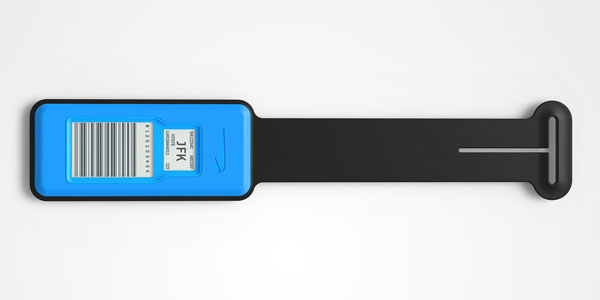Aviation
Airlines Digital Bag Tags..!! can track by smartphone.
By according to the article The Wall Street Journal For decades, fliers have checked their bags the same way: hand them to an airline employee and trust that they will reappear at the destination. Now big changes to that model are coming as airlines look to streamline the airport experience—and pass more work to customers and machines.
Their latest ideas including letting fliers tag their own bags, print luggage tags at home and track their bags on smartphones. Later this year, some fliers in Europe likely will begin using what could be the future of flying luggage: permanent bag tags that digitally update if flight plans change. Improved technology and loosened security rules are accelerating changes to baggage handling.
The changes face hurdles, including opposition from unions, security rules and fliers who prefer a human touch. On a recent weekday at Chicago’s O’Hare International Airport, several fliers struggled to tag their bag and summoned airline employees for help.Still, carriers are plowing ahead. More than a third of global airlines now ask fliers to tag their own bags, compared with 13% in 2009, according to SITA, an airline-technology firm. By 2018, more than three-quarters of carriers intend to offer the service. source (WSJ)



Customers travelling with British Airways through London Heathrow’s Terminal 5 have begun to test the personalised digital bag tag being developed by the airline. Employees from Microsoft have been chosen to take part in the month-long trial, using a specially adapted version of the British Airways app, to provide essential feedback that will help shape the final product.The digital bag tag, which contains all a customer’s baggage details, could eventually do away with the need for a new paper tag every time you fly. Comprehensive testing of the tag has already taken place to make sure it works in a live airport environment and can stand up to the rigours of airport baggage systems and everyday travel. (Source- airportinternational)
During the recent month-long test of the digital tags on British Airways flights between Seattle and London, “all bags went where they needed to go,” said Glenn Morgan, the airline’s head of service transformation. He declared that digital tag a success, but said the next step is expanding the type of smartphones that can program them. “Right now only Android and Windows phones support NFC,” said Morgan, and the airline wants to make sure the tags work fully with Apple phones as well.(source cnbc )
How it works ?
Air France, KLM and partners have worked for the past year on developing an innovative electronic bag tag and baggage tracker.It enables customers to label their luggage at home, drop bags at the fast bag drop and trace their luggage worldwide.
liked it ..! ?
Share with your friends and families

Aviation
Boeing, Antonov to Collaborate on Defense Projects

– MOU represents Boeing’s commitment to work with Ukrainian industry
– Includes exploring opportunities for collaborating on in-country support of Unmanned Aerial Systems
A Memorandum of Understanding was signed today by Boeing and Antonov Company to investigate potential collaboration on defense-related projects.
“We’re happy to keep collaborating with the Antonov Company to help Ukraine’s economic development and expansion,” stated Ted Colbert, CEO and president of Boeing Defence, Space, & Security.
Airbus and the Antonov An-225: The Best Partnership:Click here
“This agreement demonstrates our ongoing efforts to find more opportunities to work with Ukrainian industry, which was underscored by our signing of the Ukrainian Defence Industry Compact earlier this year.”
The areas of potential collaboration identified in the agreement consist of training, logistical support and overhaul services for tactical Unmanned Aerial Systems utilized by the Ukrainian Armed Forces, which includes the ScanEagle. In addition, the companies will also explore opportunities for Antonov to provide engineering support to Boeing.
The six largest cargo aircraft ever built in the aviation industry:Click here
“A strong, innovative, and efficient defense industry is key to sustainable economic development and national security, and we are extremely excited to collaborate with Boeing,” said Ievhen Gavrylov, CEO of Antonov Company.
This agreement brings a whole new level of opportunity to implement the latest and most effective solutions – in addition to the possibility of future projects with Boeing in the aerospace and defense industry.”
-

 Travel1 week ago
Travel1 week agoAir India to Expand US Operations with Three New Routes After a Decade
-

 Travel2 weeks ago
Travel2 weeks agoWhy We Should Avoid These Stamps in a Passport
-

 Airlines1 month ago
Airlines1 month agoInvestigations Reveal Fake Chinese Titanium in Boeing and Airbus Jets
-

 Tech4 weeks ago
Tech4 weeks agoChina’s CATL Plans 1,800-Mile Electric Plane Launch by 2027
-

 Airport3 days ago
Airport3 days agoTop 10 Largest Airports in the World by Size
-

 Aerospace4 weeks ago
Aerospace4 weeks agoChina’s Fighter Jets Turn Wings into Autonomous Drones
-

 Airlines4 days ago
Airlines4 days agoAir India Rolls Out A350s for Delhi-New York JFK and Newark Routes
-

 Defence3 weeks ago
Defence3 weeks agoBoeing Enhances Chinook with New Engines and Block II Upgrades at $96 Million







